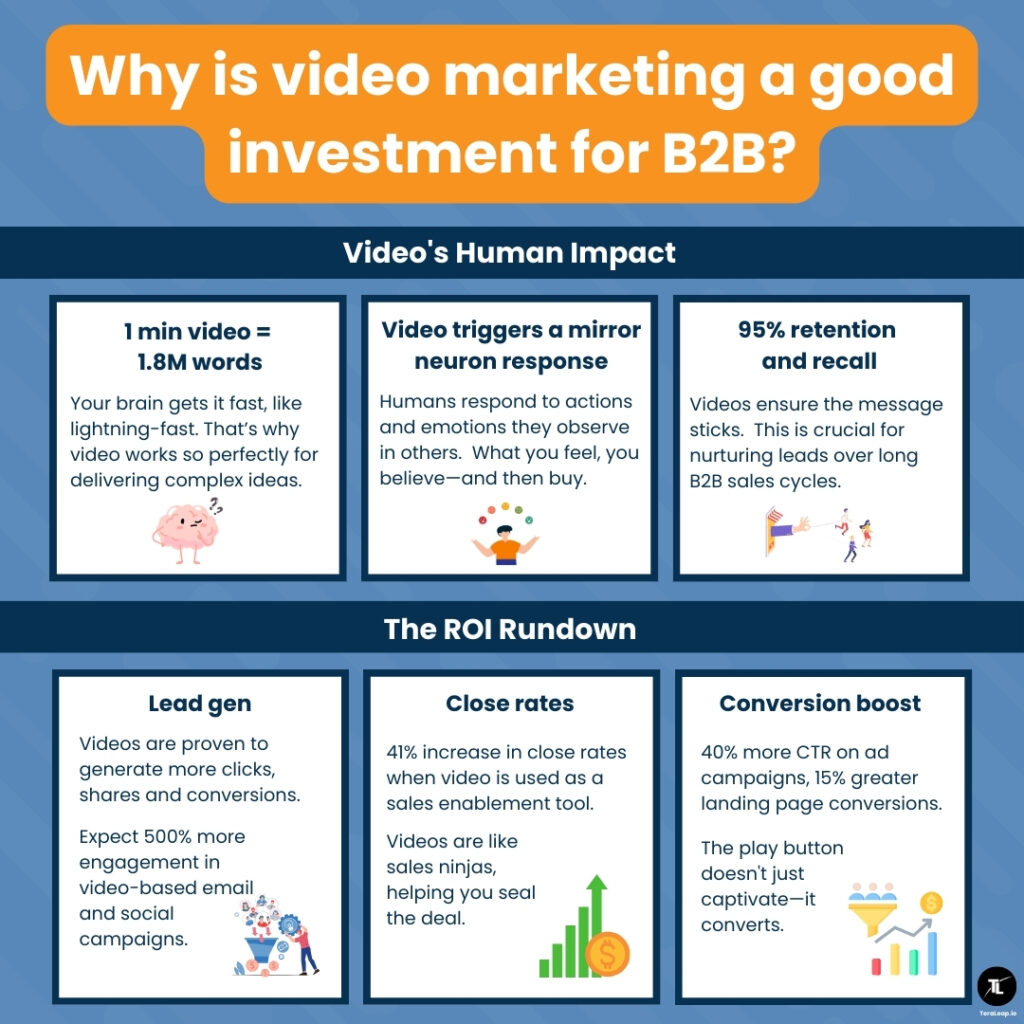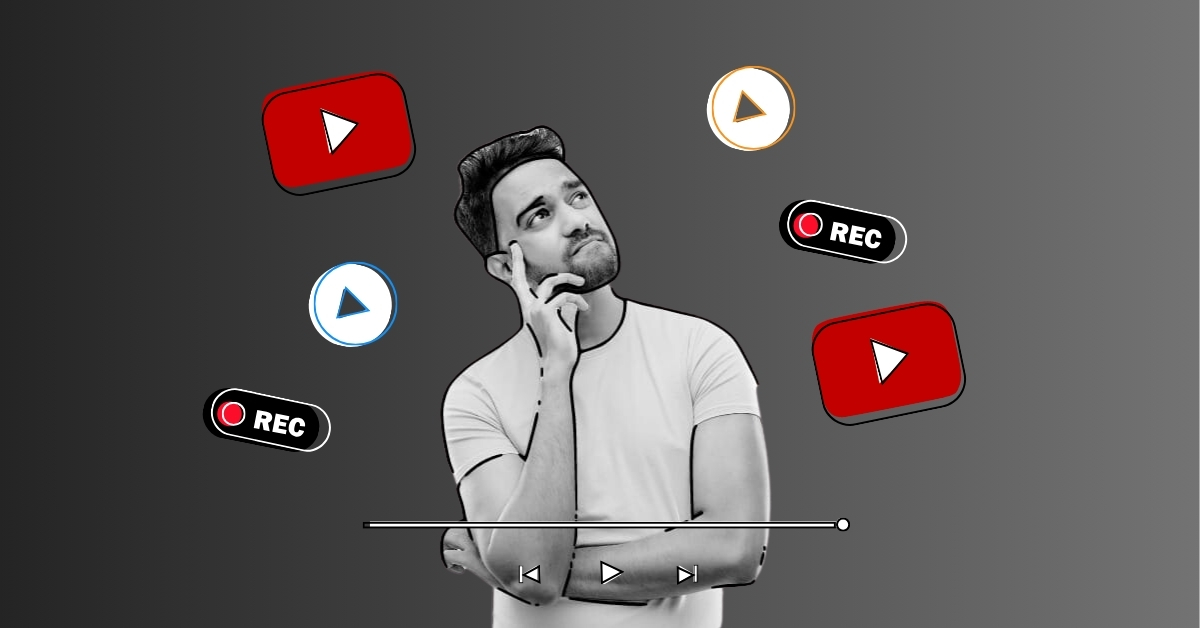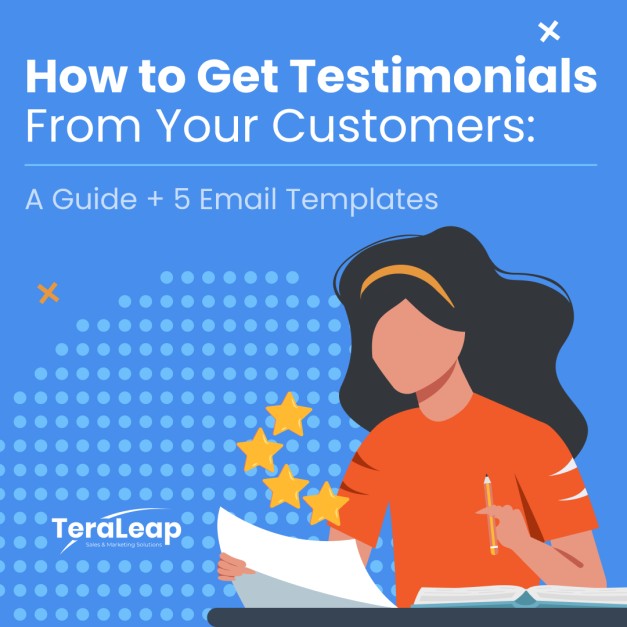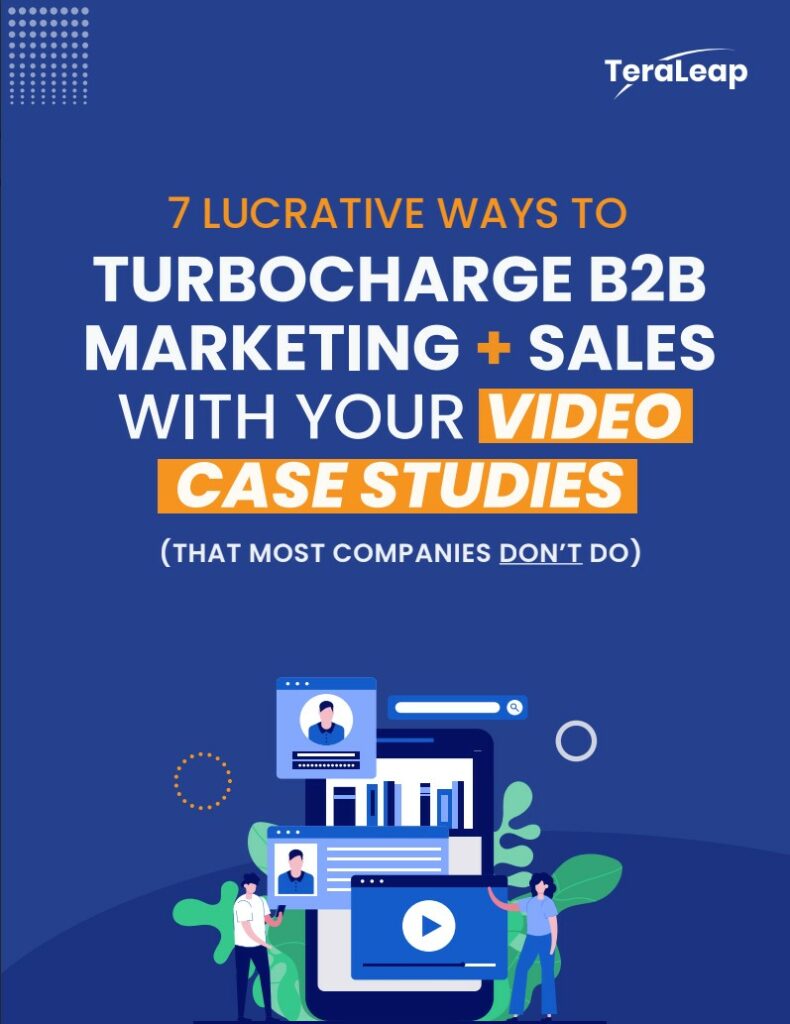Whether you’re just delving into video for your B2B marketing or focused on making B2B videos more impactful, it can feel overwhelming. This article explores seven trends in B2B video marketing that are set to dominate in 2025 and beyond.
Proclaiming 2025 as “the year of video in B2B marketing” is so 2020. Heck, let’s get real. Initial ideas about using video as part of your digital marketing strategy probably harken back to the mid-2010s.
As content guru Heike Young (currently at Microsoft and previously at SalesForce) comically stated in a January 2025 LinkedIn post:
“‘This is the year of video in content marketing.’ 🧐🧐🧐Huh? How are we still saying this?”
Humor aside, the reality is that many businesses aren’t using video in their marketing effectively. So, in this article, we’re exploring what video marketing should be in 2025:
- Video marketing should embrace authentic storytelling that’s credible
- Video marketing should focus on insights buyers seek: customer, expert, and product-focused stories
- Video marketing should alleviate buyer indecision and close the credibility gap to close more deals
In this article, we’ll examine seven trends to help you keep your video marketing efforts laser-focused on hitting sales and revenue goals in 2025.
But first, if you need to convince anyone else in your organization on WHY is video marketing essential, share this…
Why video marketing is a game changer for B2B: Closing the Credibility Gap
It’s impossible to overstate the impact of video in B2B or how effective it is as a secret weapon for winning buyers’ hearts and wallets and addressing the most common pain points B2B companies face with marketing and sales efforts
Common Pain Point |
How Video Helps |
|
Lack of Engagement |
Videos are proven to generate more clicks, shares and conversions. Expect +500% more engagement in video-based email and social campaigns. |
|
Poor Conversions |
Up to 40% more CTR on ad campaigns, 15% greater landing page conversions, and up to 80% greater demo booking rates in ABM campaigns. The play button doesn’t just captivate—it converts. |
|
Low Win Rates |
41% increase in close rates when video is used as a sales enablement tool. Videos are like sales ninjas, helping you seal the deal. |
|
Stagnant Sales Pipelines |
Video drives 56% higher proposal engagement and helps close deals 26% faster. |
Why is video so effective? It comes down to sales psychology. Compared to other content formats (e.g., written case studies, white papers, articles), video:
- Is memorable and easy to digest: A one-minute video conveys the information in 1.8 million words. Your brain gets it fast, like lightning-fast, and retains it with an estimated 95% retention and recall. That’s why video works so perfectly for delivering complex B2B ideas.
- Puts a face to the words: Most people aren’t eloquent or politically persuasive in their speech, but the sincerity in their eyes and facial expressions is universally recognized and understood, creating a strong impact on other people’s decision-making.
- Gives a voice behind the words: We intuitively understand and trust faces, but that’s just one element of the persuasion pie – voices are the secret ingredient. As social animals, we’re primed to detect the many nuances of the human voice, and those words take a unique highway deep into the parts of the human brain that handle emotion and decision-making.
By giving marketing messages a face and voice and making them digestible, video helps companies bridge the Credibility Gap—the primary barrier preventing buyers from saying “yes.” First explored in Geoffry Moore’s 1991 book “Crossing the Chasm,” the Credibility Gap is where fear, uncertainty, and doubt thrive, paralyzing decision-making.
While buyers have always demonstrated a tendency towards risk avoidance, skepticism and indecision have grown dramatically in recent years due to generative AI, fake reviews, and easily fabricated online presences.
Video content showcasing real people and real stories address buyer doubt and objections (a.k.a., the Credibility Gap), leading to more sales and faster revenue growth. Video has shifted from being a “nice to have” to becoming a fundamental part of successful marketing and sales strategies.

“Video works—on LinkedIn, videos are shared at 20x the rate of any other type of post.”
– Alex Morales, Senior Content Marketing Manager at LinkedIn
Trend #1: Authentic video storytelling: Connect on an emotional level
The good news is that as video has become a table-stakes marketing strategy, creating videos has never been easier.
A plethora of AI-powered video tools has opened the door to quickly building high-quality videos at a fraction of the cost, either in-house or with the help of tech-savvy video production companies.
In short, video has become democratized. Yay!
But that means simply having a video is no longer a differentiator.
The real challenge has become: How do you create videos that resonate and close deals?
Think about 2025 video marketing this way:
- Tools enable creativity: AI and other video solutions simplify production, allowing you to focus on the story instead of logistics, but….
- Storytelling drives revenue: A compelling narrative allows you to connect, engage, and motivate your audience to take action.
Humans are emotional beings. We’re hardwired to respond to stories and connect with them on an emotional level. Great storytelling creates those connections. Three story types that should be the pillars of every brand include:
- Customer stories
- Expert/thought-leadership stories
- Product stories
We’ll unpack each of these story types below, but genuine storytelling is the number 1 video trend and should be at the root of all your video marketing.
Storytelling bridges the Credibility Gap by focusing on your customers’ challenges, goals, and aspirations. If you can elevate your videos into stories, you can pull potential customers into a narrative that resonates and drives them to take action (e.g., engage, convert, buy).
Why authentic video storytelling is hot this year
Hollywood has capitalized on connecting with viewers on an emotional level for years. B2B marketers need to take a similar approach.
Stop treating B2B decision-makers as robots that make choices based solely on logic, ROI, and bottom lines. Address them as the humans they are, with the same irrational feelings and biases as the rest of us.
Storytelling, particularly in video format, is a powerful tool for bridging the Credibility Gap between the known and unknown. Regardless of the video’s focus—customer success, thought leadership, or how-to—ensure each contains a story the target audience can relate to. Focus on transforming unfamiliar abstract concepts into experiences people can recognize and feel.
“Storytelling is the most powerful way to put ideas into the world today.” — Robert McKee, author of Story: Substance, Structure, Style and the Principles of Screenwriting
Tips for using storytelling in your video strategy
- All stories, including those in narrative B2B marketing, follow a hero’s journey and have an arc that people are primed to respond to. Study classic storytelling techniques and play your story out in three acts—the introduction of a pain point, the ramp up of tension to a climax, and then the resolution.
- Use relatable characters your audience will respond to. In video testimonials, for example, the “characters” are already there—your customers!
- Every story needs a hero, and your company is not it. When storytelling goes wrong, it’s often because the brand is painted as the hero, swooping in to save the day. Your audience wants to see themselves as the hero, with your brand playing a supporting role.
- Use music to drive the narrative and add emotional weight to your videos. Star Wars would not be the emotionally affecting juggernaut that it is without John Williams’ iconic score.
- Back your story up with data. Stories are the best tool for shifting B2B content from dry to dynamic, but you must show how your product or service delivers tangible results. Use data and statistics to support the narrative of your story.
- Throw in a little humor! A good laugh can break the ice and make complex information stick. Remember: the goal is to make them smile, not turn your brand into a stand-up act. Keep it tasteful and clever to ensure the chuckles boost your message, not bury it.
Examples you can learn from
- “The Client” by Teamwork
- GA4 Oppenheimer Parody from analytics platform Matomo
- PSA from Siroko “How much life is consumed by your phone?”
Trend #2: Customer videos: Building trust with real stories
Customer stories should be your first pillar of a solid marketing strategy because they ground your company’s aspirational value props with real day-to-day customer advantages.
These stories can be quick quotes and testimonial video clips or longer video case studies. They address the critical buyer question: “Does this work for others like me?”
Customer videos slice through the hype and get to the heart of what matters most: how your product or service has made a tangible difference for a real B2B organization. They’re powerful because, unlike written case studies tucked away in a single section of your website, video testimonials can be strategically embedded across your entire digital real estate—on web page elements, in email campaigns, or as snippets in social media posts and targeted ads. At tradeshows, they draw in the crowd, while in webinars, they add the ability for third party validation without needing more of your customers time.
Why customer videos are hot this year
Skepticism runs high in B2B. With peer recommendations influencing more than 90% of B2B buying decisions, testimonials and case study videos are critical for building trust and backing up your claims. Especially if you’re selling complex, high-risk and expensive solutions, the trust earned through customer videos can help speed up sales cycles and drive more revenue.
Showcasing existing customers’ success provides external validation and proof that your solution delivers results. Compelling customer videos embrace these concepts:
- They showcase genuine emotion and authenticity
- They clearly outline the problem and why it was critical to solve
- They share clear and measurable results
They’re also efficient. A single video can be repurposed into dozens of other assets, giving you more bang for your buck across the entire marketing and sales funnel.
Tips for creating high-impact customer videos
- Choose customers who have achieved impressive results or used your product in an interesting way—those with a story of impact to tell.
- Sweeten the deal with incentives that reflect your appreciation, like a discount on future purchases or a feature in your company’s content. A personalized, value-added outreach goes a long way in getting the ‘yes’ in customer video requests.
- Gold-standard customer videos are emotionally engaging, rich in specific details, and rooted in tangible outcomes. Don’t just enthuse—get to the meat and numbers of how your product has helped customers solve particular problems and succeed.
- Aim for a natural, unscripted conversation, but give the customer some talking points and guardrails to keep them on point. Strike a balance between letting your customers speak freely and guiding them in the right direction.
- Though on-location recordings will get you the highest quality, they’re not always practical or budget-friendly. Instead, consider more affordable options like remote video recordings, which allow your customer to comfortably share their story with minimal interruption from their office or home.
Examples you can learn from
- Apple’s B2B on-location video testimonial film on AJ Hackett Bungy New Zealand
- UGC style testimonial for Intuit
- Vitaly’s remotely-produced video testimonial with Navattic (disclaimer: we produced this 😉)
Gold standard video customer testimonials have three key qualities: they are emotionally engaging, rich in specific details, and rooted in tangible outcomes.
Trend #3: Thought-leadership videos: Level up your industry authority
Thought-leadership videos (or Expert Videos) should be the second pillar in your marketing strategy because they close the Credibility Gap and drive sales and revenue by demonstrating knowledge about pain points and trends affecting your target audience.
These stories can include everything from an external influencer sharing industry-level insights to a founder, sales leader, or solutions architect discussing what they’ve experienced firsthand or heard from customers and how your company is tackling those challenges.
Expert (thought-leadership) videos address concerns from buyers wondering: “Does this company understand my industry and my needs?”
The hard truth is that B2B decision-makers are swamped with content and pressed for time. They value thought leadership content but don’t want to waste time reading a dissertation or a low-stakes rehash of what they’ve read. Almost four in 10 decision-makers say mediocre thought leadership decreases their respect for an organization, so getting it wrong is more than a wasted opportunity.
Why thought-leadership videos are hot this year
Thought-leadership videos rank high in 2025 marketing priorities because publishing this type of video hasn’t become a mainstay…yet.
Done well, stories from internal and external experts can instill buyer confidence and set you apart from competitors by:
- Addressing key industry challenges prospects face
- Offering actionable insights about those challenges
- Connecting your company’s solutions to solving those pain points
Thought-leadership videos can do all of the above in a direct way that customer videos sometimes can’t. The aim is to cut through the noise by providing your audience with expert insights they can’t find anywhere else, positioning you as a go-to authority in your industry.
Three primary styles of expert videos include:
- Interview: A discussion between two or more people. Typically, longer-form content that can be repurposed into snackable clips.
- Lecture: One person on camera shares personal expertise. This can be polished or low-fi, but it is often shorter and can be repurposed in smaller clips.
- Skit: One person recreating a scene or situation, often humorously, to “edutain” the audience.
Check out 3 LinkedIn Expert Video Styles to explore the pros and cons of each approach.
Tips for creating killer thought-leadership videos
- Hone in on bleeding-edge trends, fresh research and developments shaking up your industry and consider how that translates to video. What’s the best format—a round table, an expert talking head, a chatty debate with your business partners?
- Build your case from evidence or first-hand stories, using crunchy stats and hard facts to support your arguments. Just because it’s a video doesn’t mean you can scrimp on research and substance.
- Get the right experts on camera. Inviting industry leaders and influencers alongside internal subject matter experts can offer fresh perspectives and draw in new audiences interested in hearing from these figures.
- Your reputation is on the line, so avoid being overly promotional or sales-y in favor of showcasing genuine expertise. But at the same time…
- Make it actionable. To ensure ROI, you must incorporate real-world applications of your product and explain how it addresses the industry challenges you’re noticing. Video is perfect for this, as it allows you to show how your solutions work in practice.
Examples you can learn from
- Interview style: Dave Gerhart and Anna Furmanov
- Lecture Style: Sahil Patel and Sara Lattanzio
- Skit Style: Heike Young and Todd Clouser
Trend #4: Product videos: Showcase your offerings
Product videos are the third pillar of a credibility-focused marketing strategy because they visually present the solution’s value and why customers should buy.
These videos can be voice-of-God overviews of your products or more personal narratives where a salesperson or solution architect walks prospects through a step-by-step approach to common customer challenges.
Regardless of the approach, product stories should address the key buyer question: “How does this product solve my specific problem?”
Product videos can be a powerful way to help prospects quickly understand the need for your solution. They also perform well in search results for product-related queries, making it easier for current and potential customers to find and engage with you.
Why product videos are hot this year
In a word—clarity, clarity, clarity. Okay, that was three words, but lack of clarity about why your solution matters is one of the main reasons for lost deals and churn
Gone are the days when B2B product demonstrations just show what you’re selling. Today’s brands are giving B2B decision-makers a full video experience with snappy demos, in-depth explainers, and how-to walk-throughs that are both immersive and educational.
Great product videos provide a story arch that:
- Highlights the practical, problem-solving capabilities of your solution
- Illustrates how specific features lead to tangible outcomes
- Demonstrates your product’s value in action, connecting features to benefits
Within each format, you can reveal how the product is used and has led to success in real-life scenarios.
Animations are still cool in product videos, but I’m seeing more brands transition towards featuring real people interacting with their products. This could be a simple voiceover with screen recording, a conversational YouTube-style vlog, or a full-on live production with professional actors telling the story.
Whatever the format, there’s a clear move towards adding a much-needed human touch to the product experience to help buyers feel confident in their purchase.
Tips for creating high-value product videos
- All stories, including those in narrative B2B marketing, follow a hero’s journey and have an arc that people are primed to respond to. Study classic storytelling techniques and play your story out in three acts—the introduction of a pain or problem, the ramping up of tension to a climax, and then the resolution.
- Use relatable characters your audience will respond to. In video testimonials, for example, the “characters” are already there—your customers!
- Every story needs a hero and your company is not it. When storytelling goes wrong, it’s often because the brand is painted as the hero, swooping in to save the day. Your audience wants to see themselves as the hero, with your brand playing a supporting role.
- Use music to drive the narrative and add emotional weight to your videos. Star Wars would not be the emotionally affecting juggernaut that it is without John Williams’ iconic score.
- Back your story up with data. Stories are the best tool in your box for shifting B2B content from dry to dynamic, but you still need to show how your product or service delivers tangible results. Use data and statistics to support the narrative of your story.
- Throw in a little humor! A good laugh can break the ice and make complex info stick. Just remember: the goal is to make ’em smile, not to turn your brand into a stand-up act. Keep it tasteful and clever to ensure the chuckles are giving your message a boost, not burying it.
Examples you can learn from
Trend #5: Education and training videos: Sharing knowledge, winning loyalty
Let’s face it, we’ve all hit up YouTube for a quick how-to on how a product works. Well, surprise—your customers are doing the exact same thing.
Educational videos go deeper than expert videos, providing more hands-on knowledge and walkthroughs. They might have similarities to product videos, showcasing in-depth demonstrations of your solution in action. The key purpose is to share knowledge thereby engaging, retaining, and expanding relationships with your customers.
From webinars to training videos, step-by-step guides, expert-led tutorials and online academies, there’s no limit to the types of video education you can offer. Video education is superior to text-based learning in terms of retaining information. It’s also super convenient for customers who want to learn on their own time and terms.
Why video education is hot this year
Let’s face it, we’ve all hit up YouTube for a quick how-to video when faced with a common problems or questions, like “How to fix a leaky faucet” or “best way to tie a tie”. Well, surprise—your customers are doing the exact same thing, and not just for personal problems anymore.
YouTube has reemerged as a key channel for B2B marketers. Consider that how-to videos are among the best-performing content on the platform, so prioritize your marketing and video efforts accordingly.
While hands-on product training videos are great, venturing beyond the features and functions of your offerings can reap considerable benefits. Educational videos are about going top-of-funnel and sharing broader knowledge about your industry and customers’ challenges rather than just focusing on specific solutions. They’re like thought leadership but more concrete, organized, in-depth, and with actionable tactics—perfect for building awareness.
Tips for creating stand-out educational and training videos
- Kick things off with video podcasts. Since you’re not dealing with complex visuals, it’s easier to get started, and you can learn a lot about what your audience is into. From there, focus on creating targeted video tutorials based on the most popular episodes and audience feedback.
- Focus on one topic at a time in your educational videos and dive deep, packing in the value. Aim for the 3 to 15-minute zone. You can go longer than traditional promotional videos (2-3 minutes), but for anything over 15, consider breaking into multiple videos.
- Elevate internal experts inside your organization to be on camera or team up with industry experts for added credibility and reach.
- Load up on all the visual goodies—slides, memes, screenshots, animated motion graphics—the visual cues that make everything more fun to watch.
- For longer videos, provide clarity on the content inside the video with timestamped chapters so your customer or prospect can jump to a section they’re most interested in.
Examples you can learn from
- Motion Creative Analytics educational video with Travis Scott
- Patrick at KlientBoost lo-fi screen recording educational video
- Shoppify’s how to and product tour
Trend #6: Short-form videos: Capturing attention. Quickly
While B2C or TikTok enthusiasts have put “snackable” video content on the forefront, busy B2B buyers crave similar on-the-go content, not time-sucking brain drains.
Short-form videos, anywhere between 15 and 60 seconds, are perfect for social media platforms and fit neatly into the tiny pockets of downtime your B2B customers have in their day. Each one of these video shorts can help bridge the credibility gap.
Why snack-sized video is hot this year
While “TikTok made me buy it” trend might be derailed due to the platform’s accessibility in certain markets, short-form videos via Instagram Reels, LinkedIn Video, YouTube Shorts, is thriving and B2B marketers are starting to catch on too. These fast-paced videos are ideal for capturing audiences with short consideration spans (currently averaging 8 seconds, even for B2B professionals), since they’re quick, entertaining and easily shared.
Short-form videos are currently delivering the highest ROI of all the video formats. They’re also number one for lead generation and engagement, which is not surprising since the average watch percentage can often exceed 100% as your audience replays them over and over. That’s a pretty great impact for something you can create with a smartphone.
Tips for creating snackable videos
- Keep it crisp; 60 seconds max and potentially much shorter. Experiment with what works for your audience.
- Front-load your message to the most important information. Snackable video lives and dies by the hook, so make it count.
- What people to stick around? Try out the 1:8:30 rule to keep viewers engaged
- Think less formal, more fun. Self-expression, quirky facts and hot takes perform better on social platforms than corporate-led content, so unbottle your personality a little.
- Plug your products! As much as people love humor on TikTok, the platform is 1.7x more likely than other platforms to be used as a tool for product discovery.
- Edit for impact. Carve up your longer-forms video into bite-sized pieces and repurpose the footage in a vertical format, giving it new life.
Examples you can learn from
68% of people will watch a full video when it’s under a minute. That’s a goldmine for engagement when every second counts.
Axongarside, 2021
Trend #7: GenAI Video: A Powerful Tool—If Used Wisely
We could have easily put this trend at the top of the list—after all, it’s everywhere. But GenAI video is still in the experimental phase for most B2B brands, and while it can support all the other trends we’ve covered, it’s not a magic bullet. That’s why we’ve placed it last—it has potential, but only if used strategically.
GenAI video refers to AI-generated content, including text-to-video production, avatar-driven videos, and synthetic voiceovers. Tools like Runway, Sora, Pika, Synthesia, HeyGen, DeepBrain AI, and Icon are making it possible to generate entire videos with just a few prompts. Unlike traditional video production—where teams storyboard, film, and edit—GenAI automates parts of the process, creating content at speeds never seen before. But speed doesn’t guarantee credibility. If misused, GenAI risks diluting brand trust rather than strengthening it.
Why GenAI video is hot this year
AI-generated video enables faster content production and makes it possible to scale video personalization like never before. Marketers can create multiple variations of a message, testing different versions for different audiences without needing an entire production team. Personalization and localization also become easier—AI-driven video can dynamically adjust messaging, swap out languages, and tailor visuals to different regions instantly. Cost efficiency is another driver, making high-quality video content accessible to more teams.
But the real opportunity isn’t just efficiency—it’s in how GenAI can support better storytelling at scale. The danger is when brands see it as a shortcut, churning out synthetic content that lacks depth, authenticity, and the human connection that builds trust.
Tips on how to use this trend (without it backfiring)
What to Watch Out For
-
Be extremely cautious about using AI to create something that pretends to be real. The rise of deepfake technology and hyper-realistic avatars means it’s easier than ever to clone a person’s likeness or voice. But if your audience feels misled, your credibility takes a hit. Trust is hard-won and easily lost, and AI-generated content that blurs ethical lines will do more harm than good.
-
Another pitfall? Relying on AI to do everything. AI can generate scripts, visuals, and voiceovers all at once, but the result often feels flat, generic, and soulless. It’s no different from AI-written blog posts—technically competent, but forgettable. AI should enhance storytelling, not replace it. The moment content becomes a product of automation instead of a reflection of real brand expertise, it loses impact.
-
Finally, it’s easy to get lost in the tech. GenAI’s possibilities feel limitless—but so are the ways it can go wrong. The first version of an AI-generated video is rarely the one you can use. If you don’t set clear boundaries, you can waste hours tweaking, regenerating, and troubleshooting instead of producing meaningful content.
How to Make GenAI Work for You
-
One of the most valuable applications of GenAI right now is creative visual b-roll—dynamic background footage that enhances a story rather than replacing real storytelling. It’s especially useful for illustrating abstract concepts, futuristic ideas, or scenes that would be expensive to produce manually. But the foundation still needs to be a strong narrative. AI-generated visuals won’t save a weak story.
-
Equipping your content team with these tools is another smart move. In-house video teams are becoming more common at B2B companies, and GenAI can help them create more ambitious, eye-catching content without relying on external production. But they need to use it strategically—not get lost in the novelty of AI-driven creation for its own sake. Encourage experimentation, but set clear guidelines to keep content aligned with your brand’s credibility.
-
A final way to use AI video wisely? Create a brand avatar—don’t clone a person (or if you do, make it stand on its own). AI-generated avatars can be an extension of your brand identity, a modern version of a company mascot. Instead of making something that tries to pass as human, develop an AI-driven character with its own unique style, voice, and personality. It’s a way to embrace the technology while keeping transparency and trust intact.
Examples you can learn from
- Clay Ostrom’s visual analogy LinkedIn posts
- Aaron Morrissey creative storytelling for B2B brands
- HPE’s “Antonio Nearly” an AI avatar of its CEO, Atonio Neri
Summing up
If your brand isn’t using video, your buyers notice. Video marketing has shifted from a luxury to an expectation.
Taking a video-first approach provides many benefits. From engagement to retention and lead generation to revenue, video has an edge that is hard to deny and even harder for competitors to beat.
The key to successful video marketing in 2025 is making authentic storytelling central to your approach.
For more insights on B2B video marketing and to stay up-to-date with the latest trends, follow Alexander on LinkedIn or book a free 30-minute strategy call to discuss how to put any of these trends into action in your brand.




